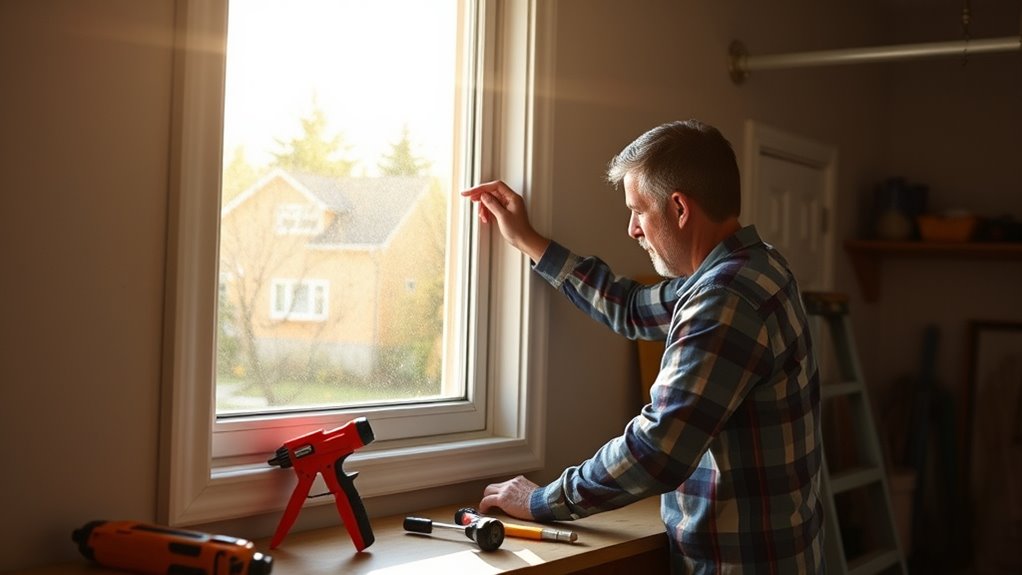To fix seasonal home problems fast, start by inspecting and sealing windows and doors to prevent drafts. Clear out gutters and downspouts to avoid water damage, and service your heating and cooling systems to keep them running efficiently. Also, check your attic and basement insulation to cut drafts and heat loss. Finally, maintain your yard to ensure proper drainage and prevent water from pooling near your home. Keep going for more tips to protect your home year-round.
Key Takeaways
- Inspect and seal windows and doors promptly to prevent drafts and improve energy efficiency.
- Regularly clear gutters and downspouts to avoid water damage and foundation issues.
- Service heating and cooling systems before peak seasons for optimal performance and comfort.
- Check and add insulation in attics and basements to reduce energy loss and drafts.
- Maintain outdoor landscaping and drainage to prevent water pooling and structural problems.
Inspect and Seal Windows and Doors
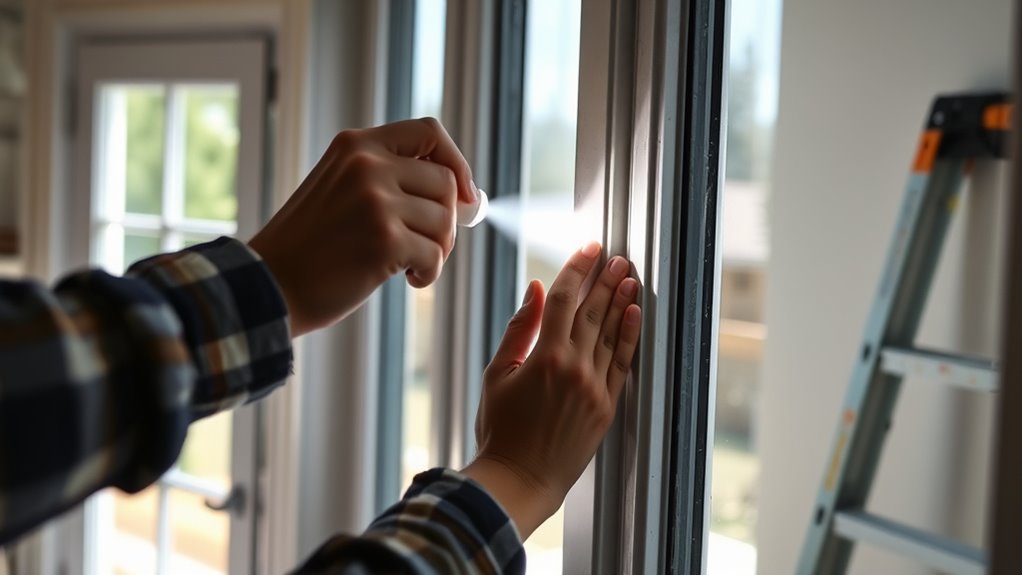
To keep your home energy-efficient and prevent drafts, it’s essential to inspect and seal your windows and doors regularly. Start by checking for gaps or cracks where air might sneak in. Replace worn weatherstripping to create a tight seal around moving parts, ensuring no drafts slip through. Look for gaps between the window or door frame and the wall, and apply high-quality caulking to fill them. This prevents air leaks and keeps your home comfortable while reducing heating and cooling costs. Pay attention to areas around locks, handles, and hinges, as these are common spots for drafts. Regularly maintaining weatherstripping and caulking helps you catch problems early and prolongs the life of your windows and doors. Additionally, proper air quality considerations can improve indoor comfort and efficiency.
Clear Gutters and Downspouts
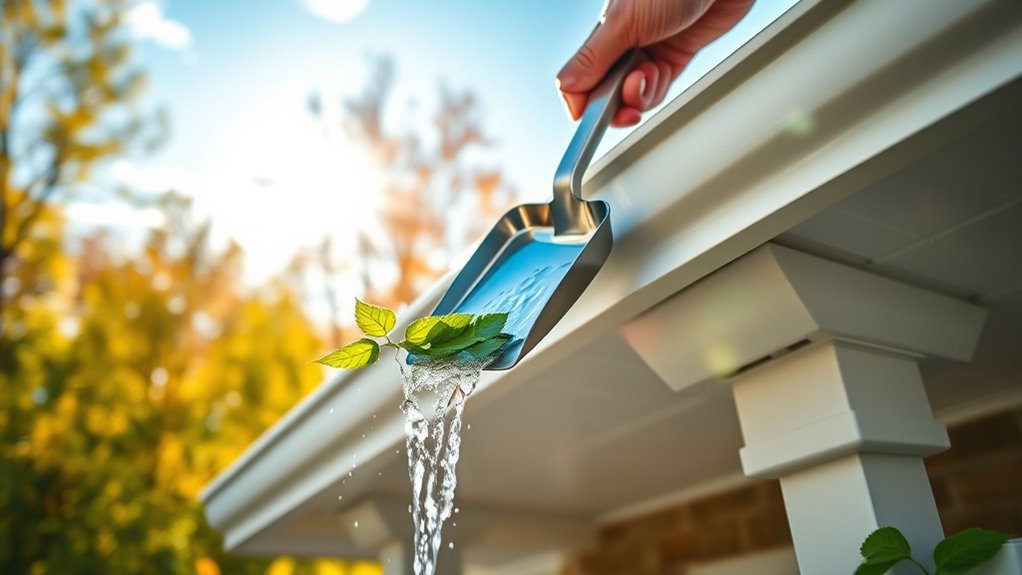
Regularly clearing your gutters and downspouts guarantees rainwater flows away from your home effectively. Start by removing leaves, twigs, and debris through gutter cleaning to prevent clogs. Use a sturdy ladder and gloves for safety, and flush the gutters with water to check for blockages. While cleaning, inspect your downspouts for damage or leaks. If you notice any issues, downspout repair is essential to ensure proper drainage. Secure loose sections and seal small leaks with appropriate materials. Ensuring your gutters and downspouts are clear and functional helps prevent water damage, foundation issues, and basement flooding. Incorporating gutter system upgrades can further improve water management. Make this a seasonal habit to keep your home protected and avoid costly repairs down the line.
Service Your Heating and Cooling Systems

As temperatures fluctuate, servicing your heating and cooling systems guarantees they run efficiently when you need them most. Regular maintenance includes thermostat calibration to ensure your system responds accurately and duct cleaning to improve airflow and indoor air quality. Neglecting these steps can lead to higher energy bills and system breakdowns. Here’s a quick checklist:
| Task | Why It’s Important | When to Do It |
|---|---|---|
| Thermostat calibration | Ensures accurate temperature control | Annually or at season change |
| Duct cleaning | Enhances airflow and efficiency | Every 2-3 years |
| Filter replacement | Maintains air quality and system health | Monthly during heavy use |
| System inspection | Detects issues early | Annually |
| Check refrigerant levels | Prevents cooling problems | Before peak cooling season |
Keeping up with these tasks ensures your system remains reliable year-round. Additionally, understanding how storage conditions can impact the longevity of components like filters and refrigerant levels can help prevent unexpected failures.
Check and Insulate Attics and Basements
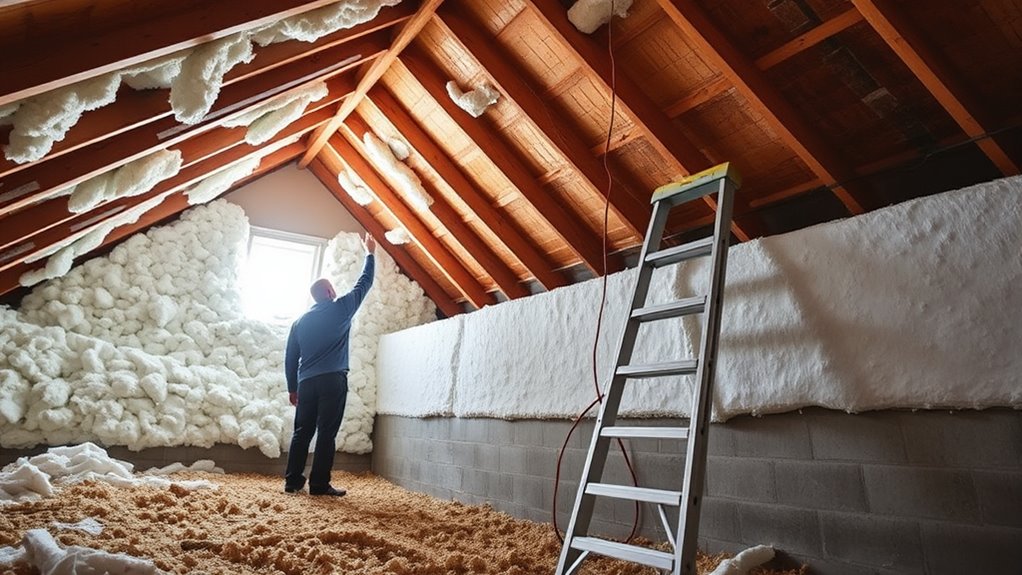
Checking and insulating your attics and basements is essential for maintaining a comfortable home and reducing energy costs. Proper attic ventilation helps prevent heat buildup in summer and ice dams in winter, while insulation keeps conditioned air inside. In your basement, insulation reduces drafts and helps regulate temperature. Address basement moisture issues by sealing leaks and adding vapor barriers, which prevent mold growth and structural damage. Verify your attic is well-ventilated to allow airflow and moisture escape, especially during humid months. Proper insulation in both spaces minimizes heat loss and keeps your home more efficient. Regularly inspect these areas for gaps or damaged insulation, and upgrade as needed to keep your home warm, dry, and energy-efficient year-round. Incorporating somatic awareness techniques can also help homeowners tune into physical discomfort caused by drafts or poor insulation, prompting timely repairs.
Maintain Outdoor Landscaping and Drainage
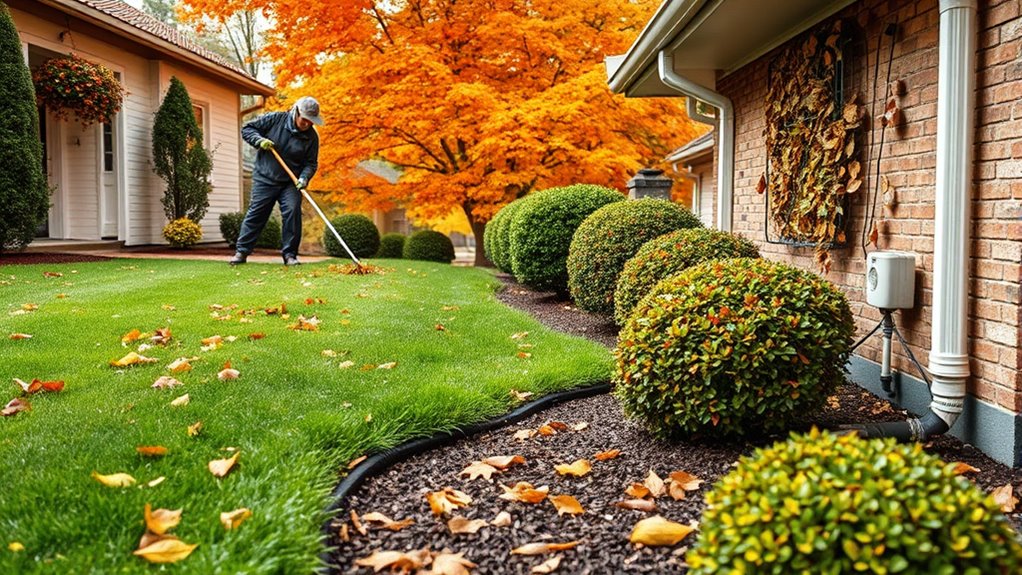
Maintaining your outdoor landscaping and drainage is essential for protecting your home from water damage and preserving your yard’s health. Start by inspecting your drainage systems and clearing out any debris that could cause clogs, especially after storms. Proper drainage prevents water from pooling near your foundation. Keep an eye out for garden pests that can damage plants and compromise your landscaping. Regularly trim overgrown shrubs and remove dead or diseased foliage. Ensure your irrigation systems are working efficiently, avoiding overwatering that can lead to soil erosion or water runoff. Properly maintained landscaping not only enhances your curb appeal but also shields your home from seasonal water issues. Home energy audits can help identify areas where water intrusion might be occurring, allowing for more targeted repairs. Stay proactive to keep your yard healthy and your home protected year-round.
Frequently Asked Questions
How Often Should I Perform Seasonal Home Maintenance Checks?
You should perform seasonal home maintenance checks at least twice a year, aligning with your seasonal checklist and maintenance schedule. In spring, focus on cleaning gutters, inspecting HVAC systems, and checking for water damage. In fall, prepare for winter by sealing drafts, inspecting the roof, and servicing heating systems. Regular checks help prevent costly repairs, ensuring your home stays safe and comfortable year-round. Stick to your schedule for best results.
What Are Signs of Hidden Water Leaks in My Home?
Hidden water leaks are like silent thieves, draining your resources unnoticed. You might notice a sudden spike in your water bill, musty odors, or discoloration on walls and ceilings. Conduct regular plumbing inspections and leak detection to catch these sneaky issues early. Listen for the sound of dripping or running water, and check for damp spots. Addressing leaks promptly prevents costly damage and keeps your home safe and dry.
How Can I Prevent Ice Dams on My Roof?
To prevent ice dams on your roof, make certain your roof insulation is adequate to keep heat from escaping and melting snow. Regularly clean your gutters to prevent ice buildup and ensure proper drainage. You might also consider installing heated cables if ice dams persist. These steps help maintain proper roof temperature and prevent water from backing up under your shingles, reducing the risk of damage and leaks during winter.
What Tools Are Essential for DIY Home Maintenance?
You’ll want a good maintenance kit that includes essential seasonal tools like screwdrivers, pliers, a hammer, and a level. Keep a ladder for those hard-to-reach spots, a utility knife for quick cuts, and a flashlight for low-light tasks. Stock up on safety gear like gloves and goggles. Having these tools ready guarantees you can handle seasonal maintenance tasks efficiently and keep your home in top shape year-round.
When Should I Consider Professional Help Instead of DIY?
When in doubt, it’s better to call a pro than to risk a home safety emergency. If a repair requires specialized tools, expertise, or could compromise your emergency preparedness, seek professional help. Don’t push through complex electrical, plumbing, or structural issues yourself. Knowing when to step back protects your home and loved ones. Trust your instincts—if it feels risky, it’s time to bring in an expert.
Conclusion
By tackling these quick fixes, you’ll prevent your home from turning into a seasonal disaster zone—no more icy drafts or waterlogged walls! With just a bit of effort, you’ll save yourself a fortune on repairs and avoid turning your house into a wild jungle or icy fortress. So roll up your sleeves, stay ahead of the chaos, and keep your home the sanctuary it’s meant to be—safe, cozy, and totally disaster-proof all year round!

